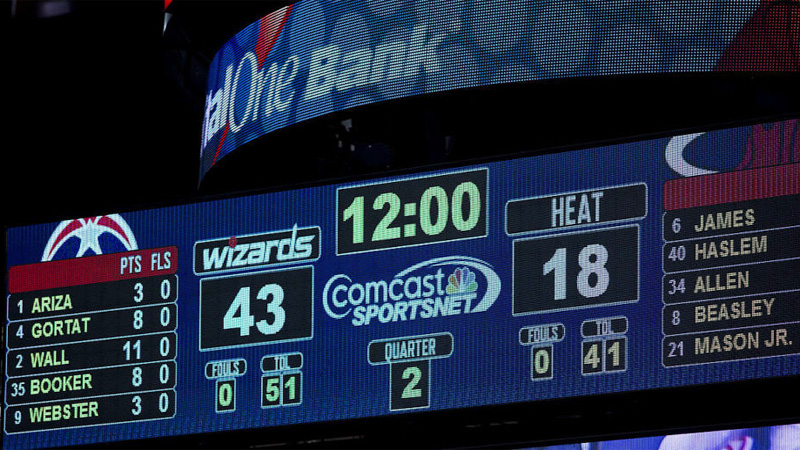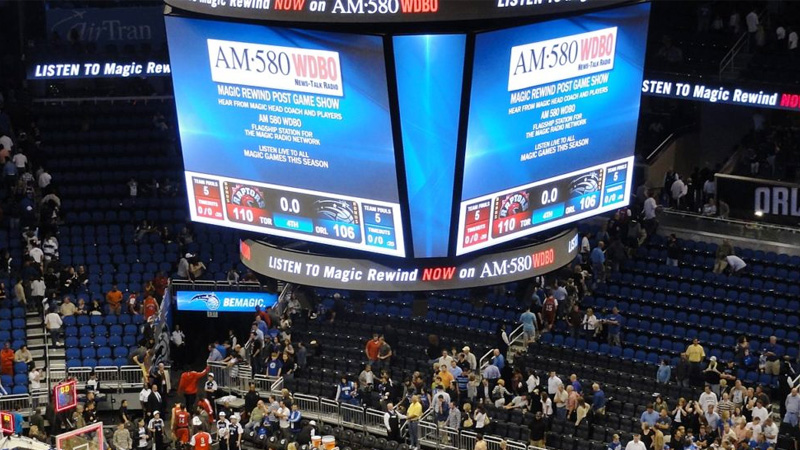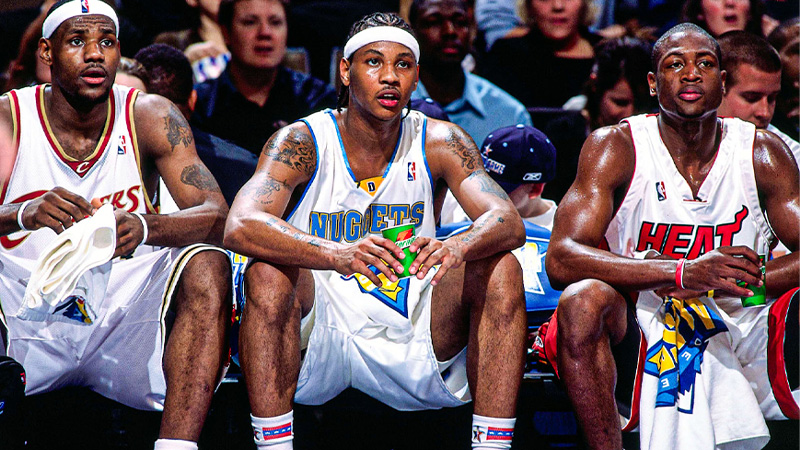Have you ever wondered how NBA players manage to keep track of the score amidst the intense chaos of a fast-paced basketball game? As spectators, we rely on the scoreboard to stay informed, but for these elite athletes, it’s more than just glancing at the digits on the screen.
NBA players possess a unique level of in-game awareness and a set of tools that help them maintain constant knowledge of the score.
In this blog post, we’ll delve into the fascinating ways NBA players know the score and how this awareness influences their decisions on the court.
Do the NBA Players Look Up to Check the Score?
NBA players generally do not look up to check the score during games. Instead, they rely on the scoreboards placed above the basketball court or the digital score display on the arena’s jumbotron.
The scoreboards are easily visible from the court and provide real-time updates of the game’s score, time remaining, and other relevant information.
Looking up to check the score during the game could be distracting and may lead to a loss of focus, so players tend to keep their attention on the court and their teammates.
They are usually aware of the score through their coaches, teammates, and in-game score displays.
However, it’s worth noting that some players may occasionally glance at the scoreboard during breaks in play, such as timeouts or free throws, to get a quick update on the game situation. But during active play, their focus is primarily on the game itself.
How Do NBA Players Know the Score?

Source: thestadiumsguide
In the fast-paced and intense environment of an NBA game, players must have a constant awareness of the score to make strategic decisions and execute plays effectively.
Understanding the score is crucial for determining the team’s position in the game, deciding on offensive and defensive tactics, and managing the clock to maximize their chances of winning.
Here’s how NBA players know the score and maintain this awareness throughout the game:
Scoreboard
The most obvious and reliable source of the current score is the scoreboard, which is prominently displayed at both ends of the basketball court. The scoreboard shows the total score for each team, the period or quarter being played, and the time remaining in that period.
Players can glance up at the scoreboard during breaks in play, such as timeouts, free throws, or after scoring a basket.
Coaching Staff
NBA teams have an entire coaching staff, including assistant coaches and statisticians, who are responsible for keeping track of the score and other essential game information.
The head coach and assistant coaches often communicate with players during timeouts or breaks to provide updates on the score and discuss strategies based on the current game situation.
Teammates
Players on the bench or those who are not currently on the court have the advantage of seeing the scoreboard and can inform their teammates about the score and other relevant details when they are on the court.
This communication helps maintain a unified understanding of the game’s progress among the players on the team.
In-Game Awareness
Experienced NBA players develop a strong sense of in-game awareness that allows them to keep track of the score without having to look at the scoreboard constantly. This awareness is honed through years of playing and understanding the rhythm of the game.
They know how many points they’ve scored, how many points their opponents have scored, and the overall flow of the game.
Game Strategy
The score significantly influences the team’s game strategy. When behind, players might take more risks and adopt a more aggressive offensive approach to catch up.
Conversely, when leading, they may focus on ball control, defense, and running down the clock to maintain their advantage. Knowing the score enables players to adjust their game plans accordingly.
Time Management
The score, combined with the game clock, dictates how players manage the time during a game. When the team is trailing and time is running out, they must act quickly to score points.
On the other hand, if they have the lead, they may try to control possession and take valuable seconds off the clock to secure the win.
Referees and Table Officials
NBA players can also get updates on the score from referees and table officials during stoppages in play. For example, if a player is unsure of the score or wants to clarify any game-related information, they can ask the referees or table officials for assistance.
NBA players stay informed about the score through a combination of the scoreboard, coaching staff, teammates, in-game awareness, and communication with referees and table officials.
This constant awareness is essential for making split-second decisions on the court and executing strategies that will lead to success for their team.
What Do the Levels Indicate on the NBA Scoreboard?

Source: thestadiumsguide
The NBA scoreboard displays various levels of information that provide a comprehensive overview of the ongoing game. The levels on the scoreboard typically include the following:
Game Clock
This level shows the time remaining in the current period or quarter. It counts down from the standard time of 12 minutes for each quarter in regulation play. In the event of overtime, additional time periods are indicated.
Period/Quarter
This level indicates which period or quarter of the game is currently being played. In a regulation NBA game, there are four quarters. During the playoffs or in the case of a tied game, overtime periods may be played, and they are also displayed on the scoreboard.
Total Score
The total score for each team is shown prominently on the scoreboard. This score represents the cumulative points each team has scored up to that point in the game.
Team Names
The names or abbreviations of the competing teams are displayed on the scoreboard to identify which teams are playing.
Timeout Indicators
The scoreboard may show the number of timeouts remaining for each team. In the NBA, teams are allowed a specific number of timeouts per game, and they can use them strategically to rest, regroup, or discuss tactics.
Possession Arrow
The possession arrow indicates which team currently has possession of the basketball. In basketball, teams alternate possession of the ball after jump balls or at the beginning of periods.
Bonus Indicators
The bonus indicators show the number of team fouls accumulated by each team in a given period. When a team reaches a certain number of team fouls (usually five or more in a quarter), the opposing team enters the “bonus” situation. This means that the fouled team is awarded free throws for any subsequent fouls committed by the opposing team.
Shot Clock
The shot clock displays the time each team has to attempt a shot. In the NBA, the shot clock is set to 24 seconds for each possession. If a team fails to attempt a shot within the shot clock’s time limit, it results in a shot clock violation, and the opposing team gains possession.
Player Statistics
On more advanced scoreboards or displays, you might see individual player statistics, such as points scored, rebounds, assists, and other key performance metrics.
The purpose of the scoreboard is to provide both players and spectators with crucial information about the game’s progress and current situation. It helps players make informed decisions on the court, coaches strategize, and fans follow the action and understand the dynamics of the game.
When Do NBA Players Know the Score?
NBA players are aware of the score throughout the entire game. Maintaining awareness of the score is a fundamental aspect of being a professional basketball player. They know the score at all times for several reasons:
Constant Glance at the Scoreboard
NBA players regularly look up at the scoreboard during breaks in play, such as timeouts, free throws, after scoring a basket, or during stoppages in the game. The scoreboard, which is prominently displayed at both ends of the basketball court, provides real-time updates on the score, period, and game clock.
Communication with Teammates
Players on the bench or not actively participating in the game communicate with their teammates on the court. They inform each other about the score, time remaining in the period, and other critical information.
This helps ensure that everyone on the team is on the same page and can adjust their play accordingly.
Coaching Staff Updates
The coaching staff, including the head coach and assistant coaches, keep the players informed about the score during timeouts and breaks. They discuss strategies based on the current game situation and provide updates on the score and key statistics to help guide the players’ decisions on the court.
In-Game Awareness
Experienced NBA players develop a strong sense of in-game awareness. They have an innate ability to keep track of the score without having to look at the scoreboard constantly.
This awareness is honed through years of playing and understanding the rhythm of the game. They know how many points they’ve scored, how many points their opponents have scored, and the overall flow of the game.
Time Management
The score, combined with the game clock, dictates how players manage the time during a game. They need to be aware of the time remaining to make strategic decisions on offense and defense.
For example, when trailing in the final minutes, they must act quickly to score points, while if they have the lead, they may try to control possession and run down the clock.
Interaction with Referees and Table Officials
NBA players can also get updates on the score from referees and table officials during stoppages in play. If a player is unsure of the score or wants to clarify any game-related information, they can ask the referees or table officials for assistance.
NBA players continuously know the score throughout the game. Their ability to stay aware of the score and game situation is vital for making split-second decisions on the court and executing strategies that will lead to success for their team.
Whether it’s through the scoreboard, communication with teammates and coaches, in-game awareness, or interaction with officials, players always have a clear understanding of the score and its implications on the game.
FAQs
How do NBA players stay aware of the score during the game?
NBA players maintain their knowledge of the score through various means. They regularly glance at the scoreboard during breaks in play, like timeouts and free throws. Additionally, their teammates on the bench keep them updated, and the coaching staff provides strategic updates during timeouts.
Why is it crucial for NBA players to know the score at all times?
Knowing the score is vital for making split-second decisions on the court. It influences their offensive and defensive strategies, time management, and how they approach crucial moments of the game.
The score dictates whether they need to take risks to catch up or adopt a more conservative approach to maintain their lead.
How does in-game awareness help NBA players know the score?
Experienced NBA players develop a strong sense of in-game awareness. This awareness is honed through years of playing and understanding the rhythm of the game.
They know how many points they’ve scored, how many points their opponents have scored, and the overall flow of the game without having to look at the scoreboard constantly.
Do NBA players ever lose track of the score?
While rare, there are instances where players might momentarily lose track of the score due to the high-intensity nature of the game. However, they quickly regain their awareness through cues from the scoreboard, communication with teammates, or guidance from coaches.
How does the score influence NBA players’ game strategies?
The score significantly impacts a team’s game strategy. When trailing, players might take more risks and become more aggressive on offense to catch up. On the other hand, when leading, they may focus on ball control, defense, and running down the clock to preserve their advantage.
Bottom Line
The ability of NBA players to stay aware of the score during a game is a testament to their high-level athleticism and in-game intelligence.
They rely on the scoreboard, communication with teammates and coaches, in-game awareness, and interaction with officials to maintain constant knowledge of the score.
This awareness not only allows them to make informed decisions on the court but also plays a pivotal role in shaping their game strategies and determining the outcome of the game.
The next time you watch an NBA game, take a moment to appreciate the remarkable skills these players possess in navigating the complexities of the game, all while being acutely aware of the score at every step.







